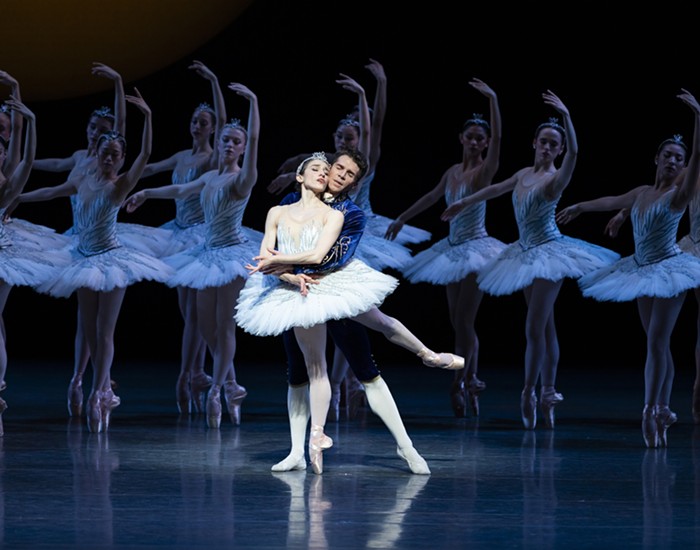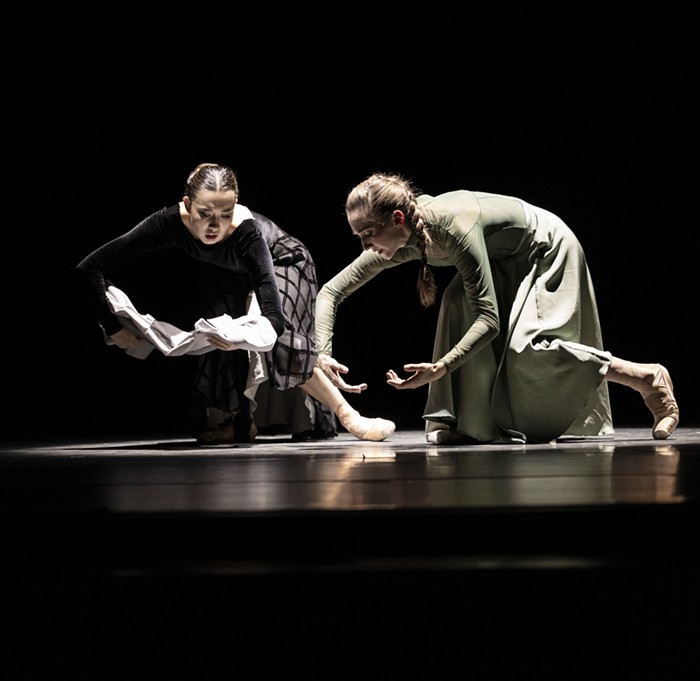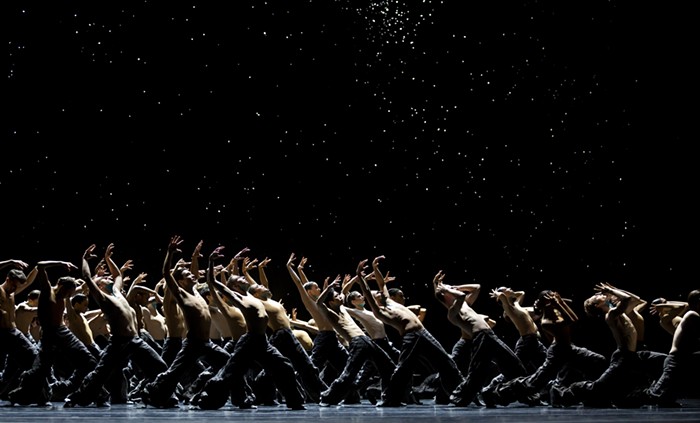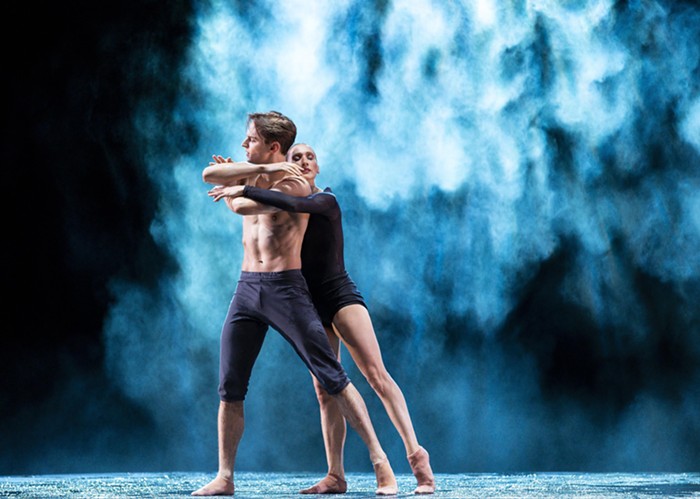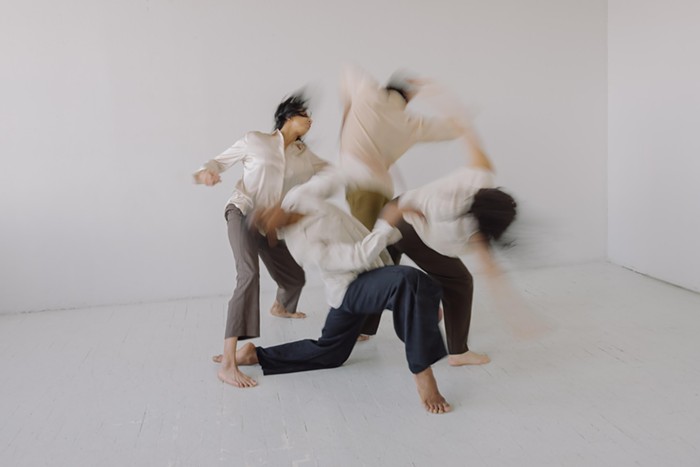
The entire audience gasped when the curtain rose on Pacific Northwest Ballet's production of George Balanchine's Jewels, which is often lauded as the world's first plotless full-length ballet, a complete choreographic embrace of high modernist ideals, a kaleidoscopic stunner, a "pure" ballet unlike any other kind of ballet the people of 1967 had seen before.
It's not uncommon to hear such a gasp for a set reveal, but the one I heard on opening night was more audible than most, sustained, and followed by lots of exasperated murmuring. A woman sitting behind me loudly and to no one in particular announced her need for an oxygen tank. People were freaking out and none of the dancers had even moved yet.

Jerome Kaplan's updated costumes were largely responsible for everyone's sudden lack of breath. Queenly crowns and tiaras shined in opalescent splendor. The men's rich, velvet tunics dazzled. The women's gossamer tutus seemed to be woven from the patches of sky that swirl with northern lights. The completely bare stage gave way to a yawning void scattered with pin-point stars. When the dancers began to move, they looked like celestial jewels twirling across the universe. The bodily joy of contrasts began to overwhelm: the hard edges of the jewels beside bulging muscles, cold rock against warm bodies, glittering emerald green blazing out of a vast, empty blackness.
It looked good! But the show would have just been a shiny pretty thing if it weren't for Balanchine's choreography, which was (for the most part) perfectly executed by PNB's principals.
Balanchine splits the show into three acts that feature three different pieces of music and three different kinds of dancing. The dancing in the opening number, "Emeralds," follows the slow swells and dips of Gabriel Fauré’s romantic music. As far as I could tell, lead dancer Noelani Pantastico continued her career-long streak of never once touching the ground during a performance. Her fluid dancing, as always, was a highlight, as was a playful ménage à trois in the fourth section, which sort of looked like a really graceful game of Red Rover.
The second act, “Rubies,” is pure fun. Igor Stravinsky’s wild, almost jazzy, strutting music had the principals moving nonstop and performing feats of athleticism every 15 seconds. At one point, Lindsi Dec became a human gyroscope, with four dancers manipulating her body into impossible shapes. Lots of intricate puzzle-piece movement characterized this section.
"Diamonds" closed out the evening with a big piece from Tchaikovsky that contained about 23 triumphant codas and, in the performance I saw, a long pas de deux between Lesley Rausch and Karel Cruz that had me slowly shaking my head in disbelief. Their chemistry was enthralling. Cruz was charming as he soundlessly landed huge leaps; Rausch's confidence beamed brighter than the jewels adorning her considerably large tiara, and her lines were diamond-cut.

Somewhere during the middle of the dance, Rausch dove into Cruz's arms head-first and then immediately flipped herself over in anticipation of being dipped, as if demanding to be the author of their romance. Just before the big finale, she stepped into the spotlight like an angel made of glass. Some woodwind made a solitary sound. She didn't move, and yet she seemed to shatter.
In that moment Rausch completed her role in a story that Balanchine had been meticulously building the entire time. While it's true there's no narrative in the traditional sense, (though little romances do seem to blink in and out of existence over the course of show), it's hard not to see a story in the shapes Balanchine creates with his choreography.
In my view, the shape-narrative of Jewels looks a little like a three-stone engagement ring and acts like a well-made play. "Emeralds" begins with the corps moving in organic ways, almost like a whirlpool or a lazy river, but ends with the dancers crystalizing into rigid, symmetrical structures. "Rubies" is the center stone, the show-off gem that's all sparkle and fun. And then "Diamonds" reflects "Emeralds" movement trajectory almost perfectly, beginning with swirling organic shapes and ending with a big, all-hands, hyper-symmetrical send-off. Instead of using the spine of an old folktale to provide the emotional content, Balanchine runs the emotions already contained in the music through this clearly defined pattern, and the completion of that pattern feels incredibly satisfying to we pattern-seeking primates. This is the genius of Jewels, and of modern dance in general.
It also helps that PNB's dancers are magnetic and incredibly good.
Given the title of the piece, as well as all the historical notes about Balanchine creating Jewels in part to show off his best female dancers at the New York City Ballet, I was worried this glorious bit of escapism might come at the cost of objectifying the women who drive each one of these pieces. But watching this production, I felt as if the exact opposite were true. These weren't women who had been turned into glistening stones, but rather women demonstrating their ability to animate stones, bringing life to a lifeless things.
So go see it this weekend! In the meantime, here's a tip: On September 29, PNB is doing a casual “Beer and Ballet” performance. You can find some main floor tickets on that day for $39.

